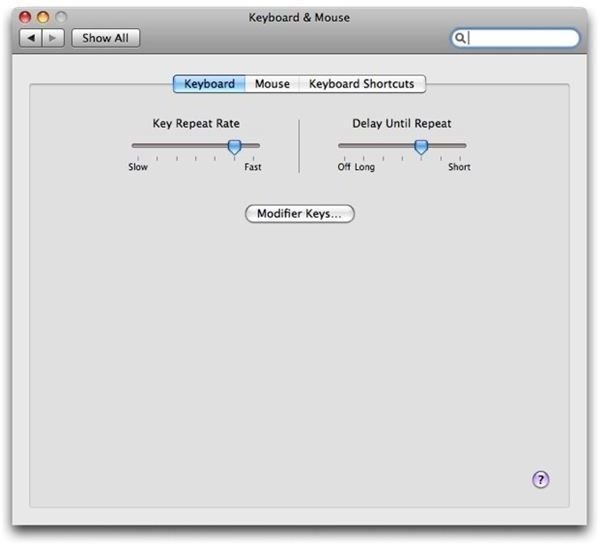How do I improve keyboard use in Mac OS X?
Improve Keyboard Use
Mac OS X 10.5 allows you to configure the way a keyboard reacts your to typing. With easy adjustments, you can make keyboard use more comfortable and easier. To change your keyboard’s settings, open the System Preferences pane then click on Keyboard and Mouse at left side of the screen. You can adjust following settings of your keyboard:
Repeat Rate
Click on the Keyboard tab button to configure the keyboard according to your style and speed. The Key Repeat Rate lets you set the speed
a key should repeat itself. Delay Until Repeat allows you to set a delay before any key starts to repeat itself.
If you can’t move fingers over your keyboard very quickly or you are a slow typist then you might like to set slow repeat rate so characters won’t repeat themselves before you will type another character. If you like, you can also set higher delay time that suits you. If you are a fast typist, you might prefer higher Key Repeat Rate and shorter delay time.
Modifier Keys
If you have a keyboard that is designed particularly for a non-Mac computer, you might find modifier keys at different places than the ones on a typical Mac keyboard. The difference in keys locations can confuse you but no worry, Mac OS X Leopard allows you change the keyboard’s modifier keys so they match with the keyboard you’re using. To change the Modifier keys, click on the Modifier Keys button, and a window will open where you can alter a modifier key to function in a different way. Just click on the button beside the key, then choose the action that you want to set using the drop-down menu. If you like, you can also turn off a modifier key by choosing No Action.
If you’re using multiple keyboards, you can choose to set different modifier key functions for each keyboard. To do so, before you set the keys, open the Select Keyboard menu on the top and choose your keyboard.
Keyboard Shortcuts
Mac OS X 10.5 allows you to assign application shortcuts, which function only in applications you want and system keyboard shortcuts, which work in all Mac OS X programs. The most common examples of keyboard shortucts includes Command-C (copy) and command-V (paste). Your can add, delete, activate and deactivate a shortcut.
For setting an existing keyboard shortcut, click on the Keyboard Shortcuts tab on the Keyboard & Mouse settings pane, you will see current shortcuts in the centre of the window. Highlight the key you want to set for the desired action then press the key or keys on the keyboard you like to use.
To create a new keyboard shortcut, click on the “+” button at the bottom-left corner of the window, a window will appear. Click on the drop-down menu at top and choose All Applications. To set a shortcut for one particular program, choose the application from the menu. If your application’s name is not in the list, select Other… then browse and choose the application from the Finder window that

opens. In the Menu title field, enter the command for the shortcut; make sure it is exactly the same as it shows in the application menu. If you need to type ellipsis, press the Option and semicolon keys together.
In the Keyboard shortcut field, press the key combination that you want to assign to the menu command then click the Add button. Close the application for which you changed or added a keyboard shortcut and restart it, the keyboard shortcut will appear in the application’s menu.
